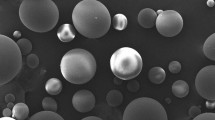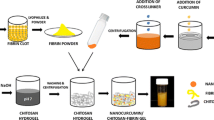Abstract
Purpose
We hypothesize that a microsphere/hydrogel combination system could be useful for the local and sustained delivery of recombinant human vascular endothelial growth factor (rhVEGF) to enhance angiogenesis in vivo.
Methods
Poly(d,l-lactide-co-glycolide) (PLGA) microspheres containing rhVEGF were loaded into alginate gels by ionic cross-linking. The rhVEGF release from the system was monitored and bioactivity was tested in vitro. The combination system was subcutaneously injected into mice using a syringe, and new blood vessel formation was evaluated.
Results
Sustained rhVEGF release from the combination system was observed for 3 weeks, and the released rhVEGF remained bioactive. Endothelial cell proliferation was significantly enhanced when cells were cultured with the rhVEGF-releasing combination system in vitro. When the combination system was implanted, the granulation tissue layer was thicker with more newly formed blood vessels than that with a single dose VEGF injection.
Conclusion
The rhVEGF release was controlled by varying relative portions of microspheres and hydrogels in combination delivery systems, which efficiently promoted new blood vessel formation in vivo. This combination system could be a promising delivery vehicle for therapeutic angiogenesis.






Similar content being viewed by others
References
Tierney EF, Gregg EW, Narayan KMV. Leading Causes of Death in the United States. JAMA 2006;295:383–4. doi:10.1001/jama.295.4.383-a.
Grossi EA, Galloway AC, LaPietra A, Ribakove GH, Ursomanno P, Delianides J, et al. Minimally invasive mitral valve surgery: a 6-year experience with 714 patients. Ann Thorac Surg 2002;74:660–4. doi:10.1016/S0003-4975(02)03754-2.
Varela E, Reavis KM, Hinojosa MW, Nguyen N. Laparoscopic gastric ischemic conditioning prior to esophagogastrectomy: Technique and review. Surgical Innovation 2008;15:132–5. doi:10.1177/1553350608317352.
Lange R, Weipert J, Homann M, Mendler N, Paek S-U, Holper K, et al. Performance of allografts and xenografts for right ventricular outflow tract reconstruction. Ann Thorac Surg 2001;71:S365–7. doi:10.1016/S0003-4975(01)02552-8.
Risau W. Mechanisms of angiogenesis. Nature 1997;386:671–4. doi:10.1038/386671a0.
Zwaginga JJ, Doevendans P. Stem cell-derived angiogenic/vasculogenic cells: Possible therapies for tissue repair and tissue engineering. Clinic Exp Pharmacol Physiol 2003;30:900–8. doi:10.1046/j.1440-1681.2003.03931.x.
Vincent KA, Jiang C, Boltje I, Kelly RA. Gene therapy progress and prospects: therapeutic angiogenesis for ischemic cardiovascular disease. Gene Therapy 2007;14:781–9. doi:10.1038/sj.gt.3302953.
Schmidt A, Brixius K, Bloch W. Endothelial precursor cell migration during vasculogenesis. Circulation Res 2007;101:125–36. doi:10.1161/CIRCRESAHA.107.148932.
Pattersonand C, Runge MS. Therapeutic myocardial angiogenesis via vascular endothelial growth factor gene therapy: Moving on down the road. Circulation 2000;102:940–2.
Wei G, Jin Q, Giannobile WV, Ma PX. Nano-fibrous scaffold for controlled delivery of recombinant human PDGF-BB. J Controlled Rel 2006;112:103–10. doi:10.1016/j.jconrel.2006.01.011.
Nomi M, Atala A, Coppi PD, Soker S. Principals of neovascularization for tissue engineering. Mol Aspects Med 2002;23:463–83.
Kannan RY, Salacinski HJ, Sales K, Butler P, Seifalian AM. The roles of tissue engineering and vascularisation in the development of micro-vascular networks: A review. Biomaterials 2005;26:1857–75. doi:10.1016/j.biomaterials.2004.07.006.
Nicosia R, Nicosia S, Smith M. Vascular endothelial growth factor, platelet-derived growth factor, and insulin-like growth factor-1 promote rat aortic angiogenesis in vitro. Am J Pathol 1994;145:1023–29.
Zakrzewska M, Marcinkowska E, Wiedlocha A. FGF-1: From Biology Through Engineering to Potential Medical Applications. Crit Rev Clin Lab Sci 2008;45:91–135. doi:10.1080/10408360701713120.
Tammela T, Enholm B, Alitalo K, Paavonen K. The biology of vascular endothelial growth factors. Cardiovasc Res 2005;65:550–63. doi:10.1016/j.cardiores.2004.12.002.
Crossand MJ, Claesson-Welsh L. FGF and VEGF function in angiogenesis: signalling pathways, biological responses and therapeutic inhibition. Trend Pharmacol Sci 2001;22:201–7. doi:10.1016/S0165-6147(00)01676-X.
Carmeliet P. VEGF gene therapy: stimulating angiogenesis or angioma-genesis? Nature Med 2000;6:1102–3. doi:10.1038/80430.
Silvestre J-S, Tamarat R, Ebrahimian TG, Le-Roux A, Clergue M, Emmanuel F, et al. Vascular endothelial growth factor-B promotes in vivo angiogenesis. Circulation Res 2003;93:114–23. doi:10.1161/01.RES.0000081594.21764.44.
Henry TD, Rocha-Singh K, Isner JM, Kereiakes DJ, Giordano FJ, Simons M, et al. Intracoronary administration of recombinant human vascular endothelial growth factor to patients with coronary artery disease. Am Heart J 2001;142:872–80. doi:10.1067/mhj.2001.118471.
Morishitaand M, Peppas NA. Is the oral route possible for peptide and protein drug delivery? Drug Discovery Today 2006;11:905–10. doi:10.1016/j.drudis.2006.08.005.
Langer R, Peppas NA. Advances in biomaterials, drug delivery, and bionanotechnology. AIChE J 2003;49:2990–3006. doi:10.1002/aic.690491202.
Lee KY, Yuk SH. Polymeric protein delivery systems. Progr Polym Sci 2007;32:669–97. doi:10.1016/j.progpolymsci.2007.04.001.
Hatefiand A, Amsden B. Biodegradable injectable in situ forming drug delivery systems. J Controlled Rel 2002;80:9–28. doi:10.1016/S0168-3659(02)00008-1.
Cleland JL, Duenas ET, Park A, Daugherty A, Kahn J, Kowalski J, et al. Development of poly(d,l-lactide-co-glycolide) microsphere formulations containing recombinant human vascular endothelial growth factor to promote local angiogenesis. J Controlled Rel 2001;72:13–24. doi:10.1016/S0168-3659(01)00258-9.
Yang Y-Y, Chung T-S, Bai X-L, Chan W-K. Effect of preparation conditions on morphology and release profiles of biodegradable polymeric microspheres containing protein fabricated by double-emulsion method. Chem Engin Sci 2000;55:2223–36. doi:10.1016/S0009-2509(99)00503-5.
Lee J, Lee KY. Injectable microsphere/hydrogel combination systems for localized protein delivery. Macromol. Biosci. in press 2009.
Lee KY, Peters MC, Mooney DJ. Comparison of vascular endothelial growth factor and basic fibroblast growth factor on angiogenesis in SCID mice. J Control Release 2003;87:49–56. doi:10.1016/S0168-3659(02)00349-8.
Zacchigna S, Papa G, Antonini A, Novati F, Moimas S, Carrer A, et al. Improved survival of ischemic cutaneous and musculocutaneous flaps after vascular endothelial growth factor gene transfer using adeno-associated virus vectors. Am J Pathol 2005;167:981–91.
Shimpo M, Ikeda U, Maeda Y, Takahashi M, Miyashita H, Mizukami H, et al. AAV-mediated VEGF gene transfer into skeletal muscle stimulates angiogenesis and improves blood flow in a rat hindlimb ischemia model. Cardiovascular Res 2002;53:993–1001. doi:10.1016/S0008-6363(01)00546-6.
Lee RJ, Springer ML, Blanco-Bose WE, Shaw R, Ursell PC, Blau HM. VEGF gene delivery to myocardium: Deleterious effects of unregulated expression. Circulation 2000;102:898–901.
Tabata Y, Miyao M, Ozeki M, Ikada Y. Controlled release of vascular endothelial growth factor by use of collagen hydrogels. J Biomater Sci Polym Edn 2000;11:915–30. doi:10.1163/156856200744101.
Caoand L, Mooney DJ. Spatiotemporal control over growth factor signaling for therapeutic neovascularization. Adv Drug Deliv Rev 2007;59:1340–50. doi:10.1016/j.addr.2007.08.012.
Acknowledgments
This work was supported by grant from World Class University Project, Ministry of Education, Science and Technology, Republic of Korea (grant no. 200900000000024).
Author information
Authors and Affiliations
Corresponding author
Rights and permissions
About this article
Cite this article
Lee, J., Lee, K.Y. Local and Sustained Vascular Endothelial Growth Factor Delivery for Angiogenesis Using an Injectable System. Pharm Res 26, 1739–1744 (2009). https://doi.org/10.1007/s11095-009-9884-4
Received:
Accepted:
Published:
Issue Date:
DOI: https://doi.org/10.1007/s11095-009-9884-4




